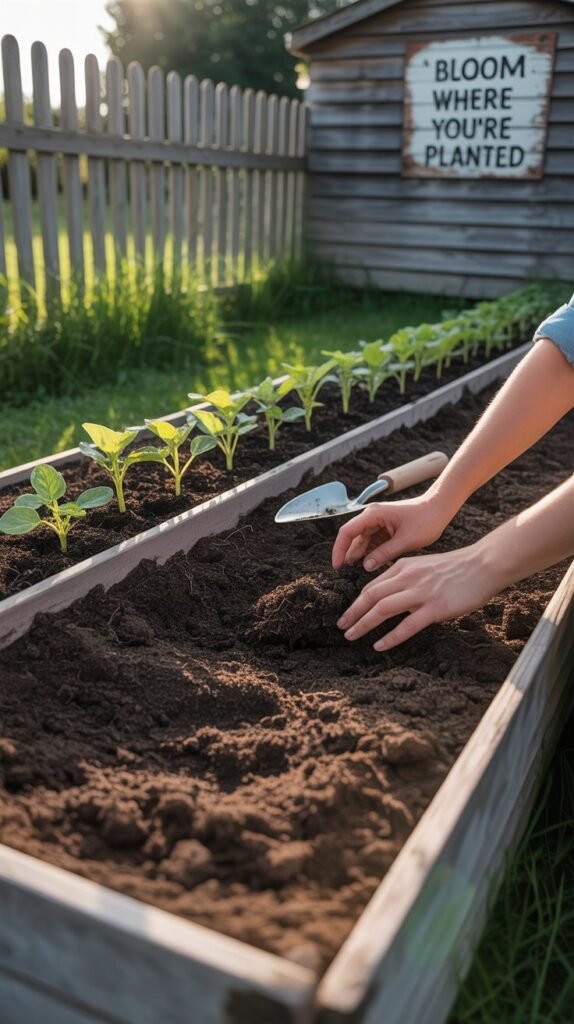Home Gardening is an enjoyable and rewarding way to grow fresh vegetables, herbs, and flowers right in your backyard or balcony.
Plan garden space for home gardening
Assess space
- Identified sunny spots firstly
- Vertically measuring available areas for small space
- Wisely choose plants which you like such as flower, vegetable and fruits
- Start with easy to grow plants like vegetable tomatoes, lettuce, radishes or herbs (basil, mint).
- Choose seasonal plants for best yield
Soil preparation for home gardening
Understand soil
- Test soil, nutrient content and drainages
- Most vegetables prefer which are low acidic to neutral soil pH (6-7)
Soil health improvement
- Add compost or well-rotted manure to enrich nutrients
- Mix in sand or perlite for better drainage if soil is heavy clay

Mulching and home gardening
Mulching basically overcome extra moisture around plant with protective material layer, these materials can be both organic and inorganic
Organic material includes
- Straw
- Wood
- Leaves
Inorganic materials includes
- Plastic sheets
- Landscape fabrics
- stones
Purpose of Mulching
Moisture retention in home gardening
- Keep Soil damp longer
- Reduces needs for frequent moisture
Weed Suppression
- Blocks sunlight
- Preventing weed seeds from germinating
Temperature regulation
- keep soil cooler in hot water
- Warmer in cold water
Soil health and Erosion prevention
- Decompose organic mulches over time
- Adding nutrients
- Improve soil structure
- Protect soil from heavy rain and wind
How to Mulch Effectively:
- Apply a layer 2–4 inches thick around plants.
- Keep mulch a few inches away from plant stems to prevent rot.
- Refresh organic mulch as it decomposes to maintain effectiveness.
Planting Techniques for a Thriving Home Garden
Seed vs. Seedlings
- Seeds are cost-effective and offer a wide variety of plant options for home gardening
- Seeds take longer to grow but give a rewarding experience from the start
- Seedlings grow faster and reduce early-care care effort
- Choice depends on gardening goals, time and budget
Spacing and Depth:
- Follow instructions on seed packets or plant labels for depth and spacing.
- Avoid overcrowding to ensure proper airflow and reduce disease risk.
- Correct spacing promotes stronger roots, better sunlight access, and higher yields.
Watering Tips:
- Water early in the morning to reduce evaporation and prevent leaf diseases.
- Keep soil consistently moist, but avoid waterlogging to prevent root rot.
- Consider drip irrigation or soaker hoses for efficient watering and moisture control.
Maintenance and Care of home gardening
Use some organic solutions
- Neem oil
- Insecticidal Soap
- Companion planting
Fertilization
- Use balanced organic fertilizers to support growth
- Avoid over-fertilization it can harm plants
Pruning and training
- Remove dead or crowded leaves to improve airflow and light penetration
- Train climbing plants like beans and tomatoes using stakes or trellises
Pest and disease management
- Inspect plants regularly
Assess space and climate for home gardening
- Think about how big the growing space.
- To choose the right plants, think the growing season and environment in your area
- Choose plants that will flourish in your region
Evaluate plant growth cycles
- Evaluate Plant Growth Cycles
- Choose the best plants by knowing whether they are annuals, perennials, or biennials
- Plan for successful succession planting to maximize yields
- Consider fast-growing varieties if you want quick and rewarding results
- Avoid the frustration of slow or poorly timed harvests by planning ahead
- Focus on Personal Preferences
Focus on personal preferences
- Grow vegetables, herbs, or flowers you enjoy consuming or seeing
- Experiment with rare or exotic plants if space and conditions allow
- Prioritize high-yield crops for small spaces to maximize harvests
- Consider Pest and Disease Resistance
- Choose varieties known for resilience against common local pests and diseases
- Look for organic or hybrid seeds designed for stronger plant health
- Budget and Maintenance
- Factor in seed or seedling cost and long-term maintenance.
- Start with low-maintenance crops if you have limited time or experience
- Consider companion planting to reduce labor and increase productivity
Harvest & health benefits
Timing of harvest
- Harvest fruits, vegetables, and herbs at peak ripeness for best flavor and nutrition
- Check plant-specific indicators such as color, size, and firmness
- Avoid overripe produce to reduce spoilage and waste
Boosting nutritional value
- Freshly harvested produce retains higher levels of vitamins, minerals, and antioxidants
- Consuming seasonal garden produce supports a balanced and nutrient-rich diet
- Homegrown foods often have fewer pesticides compared to store-bought options
- Rich in fiber for digestive health.
- Packed with vitamins (A, C, K) and minerals (iron, potassium, magnesium)
- High antioxidant content helps reduce inflammation and support immunity



